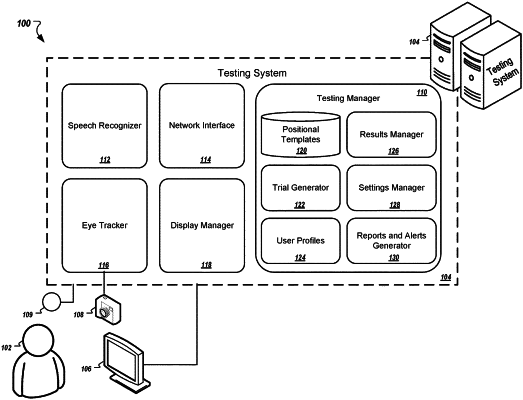| CPC G09B 7/00 (2013.01) [A61B 5/163 (2017.08); A61B 5/4088 (2013.01); A61B 3/113 (2013.01); A61B 5/162 (2013.01)] | 28 Claims |

|
1. A computer-implemented method for assessing an ocular-cognitive ability of a person through administration of an oculo-cognitive test, the oculo-cognitive test comprising a plurality of trials, each trial comprising a plurality of stages, the method comprising:
for each trial:
selecting, by a system of one or more computers, a respective set of numbers for the trial and a different respective display position for each number in the set of numbers for the trial;
for each stage of the trial after an initial stage:
transitioning to the stage by replacing on an electronic display screen a preceding number from the set of numbers that was presented to the person during a preceding stage with a current number from the set of numbers, wherein the preceding number and the current number are displayed at different respective display positions on the electronic display screen during their respective stages, wherein the preceding number is cleared from the electronic display screen and the current number appears on the electronic display screen substantially concurrently upon the start of the stage;
invoking a cognitive task to challenge the person during the stage, the cognitive task being based on the current number presented to the person during the stage and at least one preceding number from at least one preceding stage of the trial;
tracking, with one or more cameras, saccadic eye movement of the person as the person shifts his or her gaze from the preceding number at its respective display position on the electronic display screen from the preceding stage to the current number at its different respective display position on the electronic display screen for the stage, the one or more cameras comprising at least one optical sensor configured during tracking of the saccadic eye movement of the person to detect first optical inputs indicative of the saccadic eye movement and to produce a first optical output signal from which oculomotor metrics comprising at least one of a distance, a speed, or an acceleration of the person's saccadic eye movement during the stage can be determined;
tracking, with one or more cameras, a gaze of the eyes of the person on the current number at its respective display position on the electronic display after the person fixes his or her gaze on the current number, the at least one optical sensor configured during tracking of the gaze of the eyes of the person on the current number at its respective display position to detect second optical inputs indicative of the gaze and to produce a second optical output signal from which oculo-fixation metrics for the gaze can be determined;
detecting a response from the person to the cognitive task, and in response, automatically initiating a next stage of the trial if at least one additional stage remains in the trial;
determining a set of oculomotor metrics from the first optical output signals produced by the at least one optical sensor as a results of tracking the person's saccadic eye movements across multiple stages of the test, the set of oculomotor metrics describing at least one of a distance, a speed, or an acceleration of the person's saccadic eye movements during stage transitions across multiple stages of the test;
determining a set of oculo-fixation metrics from the second optical output signals produced by the at least one optical sensor as a results of tracking the person's fixed gaze on different numbers displayed in each of multiple stages of the test;
determining cognitive performance metrics based on correctness and response times of the person's responses to the cognitive tasks in each of multiple stages of the test;
providing an assessment of the ocular-cognitive ability of the person based at least in part on the set of oculomotor metrics, the set of oculo-fixation metrics, and the cognitive performance metrics;
wherein the respective display positions for the numbers displayed in a first trial of the plurality of trials comprise a first set of display positions that are selected based on a determination that the first set of display positions stimulate eye movement predominantly in a first direction during the first trial, the first set of display positions being non-linear and varying in the first direction by a greater amount than a non-zero variance of the first set of display positions in a direction orthogonal to the first direction.
|